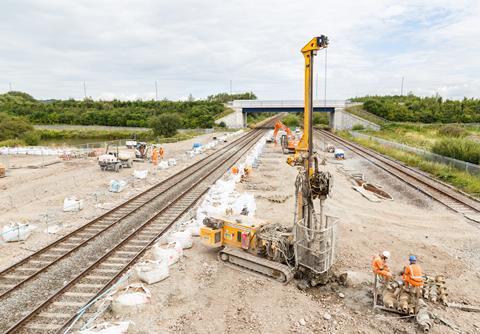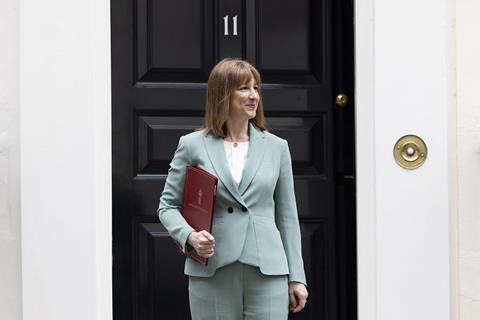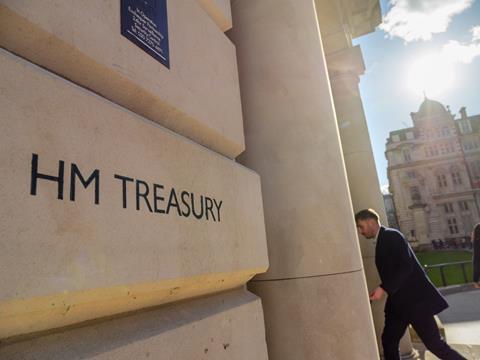Boris Johnson’s 2020 review of the Treasury’s appraisal process for government investments led to some improvements in how value in schemes is judged, but a new review commissioned by Labour this year has found that many of the old practices remain embedded. Rachel Reeves has said she wants to go further, Tom Lowe reports


Housing and infrastructure spending may have been the big ticket items at Wednesday’s spending review, but there was another major announcement which has been relatively overlooked. Rachel Reeves also promised to reform the Green Book, the methodology used by the Treasury to appraise value for money in public investment decisions.
The proposed updates, due to be published early next year, have the potential to be just as significant for public sector construction work.
The Green Book is used by the government to assess costs, benefits and risks of different options to achieve strategic objectives. There have been longstanding concerns that it contributes to regional disparities across the UK by discouraging investment in less affluent parts of the country, where returns may be smaller than if the same money were spent in, for example, London.
The government launched a review of the Green Book in January which was published alongside the spending review. It consulted a wide range of public bodies, think-tanks, academics and private firms including Arup and KPMG.
The chancellor said on Wednesday that the government wanted to ‚Äúmake sure no region has Treasury guidance wielded against them‚ÄĚ. If this is all sounding a bit familiar, it is because it was a key plank of Boris Johnson and Dominic Cumming‚Äôs levelling up agenda in 2019, much of which Reeves is now reheating.

But there are some key differences. A previous review of the Green Book in 2020 ordered by Johnson resulted in updates to the guidance increasing the weight of strategic cases within business cases for projects. Although the principles of the 2020 review have been integrated into the Treasury‚Äôs spending review processes, the latest review found many local and regional authorities believe the department has made ‚Äúinsufficient progress in improving appraisal‚ÄĚ.
Their concerns focused on two broad issues. Firstly, they believed that regional equality objectives were not always reflected in strategic cases. Secondly, they said it was often hard to express the strategic contribution of an individual project in a single business case. This is because the Green Book is generally written to support the appraisal of individual projects and programmes.
The Treasury said it has identified six elements of the Green Book which need to be addressed to ensure that ministers are receiving ‚Äúfair, objective and transparent‚ÄĚ advice on investment decisions across the UK.
More emphasis on place-based objectives
Probably the most significant update compared to the 2020 review is the proposed creation of so-called place-based business cases, which will set out the strategy and analysis for a set of proposals in a particular place. They will function like a portfolio business case, sitting above the individual project and programme business cases for specific interventions.
This aims to address the two main concerns raised during the review by requiring the strategic importance of a project to be justified by its contribution to the place-based business case, rather than by comparing it to projects elsewhere in the country.
The approach also aims to provide a means to consider the interactions between multiple projects, such as the uplift in housing demand or land value which would be created by a new transport hub or rail line.
Place-based business cases will be co-ordinated by a new taskforce within central government, which will agree a general approach and the geographical coverage of each business case.
The taskforce will be led by the second permanent secretary of HM Treasury responsible for regional growth and devolution, working with the director general for local government, growth and communities in the MHCLG and the director general for public transport and local group in the DfT. It will also involve local and regional government, and other government departments.
More effective assessments transformational change
Consultees in the review argued that, while the Green Book could assess small changes that arise from a particular spending proposal, it is less capable of measuring the transformational impacts of major investments in a particular area.
While this was acknowledged in the 2020 review, the 2025 review found this approach was still ‚Äúunclear and inconsistent‚ÄĚ and did not provide any clear direction on the schemes necessary to drive transformational change in an area.
To address this, next year‚Äôs update will assess different options for stimulating growth and development in a particular area, supported by ‚Äúrigorous‚ÄĚ evidence and analysis including DfT case studies of the impacts of existing transport schemes.
The Treasury will also commission an independent review of the social time preference rate (STPR), the discount rate on investments used to calculate future returns. It is currently set at 3.5% in real terms for the first 30 years of a proposal, falling to 3% for years 31 to 75, and then 2.5% thereafter.
Consultees argued that this framework could undermine the appraisal of long-term schemes that produce benefits far into the future. According to the Treasury, the STPR review will ensure the rate will support ‚Äúfair and accurate‚ÄĚ cost and benefit comparisons over time and make sure it does not undervalue long-term benefits.
View from our Funding the Future advisory panel

Beth West, director and founder, Navigate Advisory
“What I’m excited about with this is that the Treasury is focused on transformational change that can stimulate growth in a local area. This was problematic before, from my perspective.
‚ÄĚThe models that had previously been used did not really know what to do with those transformational changes, which seems surprising. This is partly because behaviour change, which is transformational change, is very difficult to forecast.
“I think the changes to the green book could be meaningful, and could make a difference on big schemes. I think where the problems have been in the past when looking at economic cases, and not looking at things holistically, it has tended to be really difficult to do these transformational schemes, because the numbers theoretically don’t work.
The green book changes should be helping do the analysis on these big, meaningful projects that are going to make big developmental changes
“Currently different government departments like MHCLG and the DfT have different modelling for transformational change. The place-based approach is really interesting because it’s trying to make sure that you’re doing all the modeling together. The green book changes should be helping do the analysis on these big, meaningful projects that are going to make big developmental changes, which is good.
‚ÄúOn the other hand, the Treasury is often more motivated by trying to save money rather than spending it. So I think we‚Äôll have to wait and see if it actually makes a difference.‚ÄĚ
Less emphasis on benefit-cost ratios in decision making
The Green Book currently assesses value for money using benefit-cost ratios (BCRs), which have been criticised for ignoring social benefits and social costs that are unmonetisable. These benefits and costs were better integrated into Treasury calculations following the 2020 review, but the 2025 review found the government still places too much emphasis on what can be included in a BCR.
Consultees particularly complained about arbitrary ‚ÄúBCR thresholds‚ÄĚ, which stipulate that a project can only receive funding if it has a BCR above a certain value, such as 1.0 or 2.0. This was said to result in too much time and resource focused on capturing monetisable benefits to secure funding for a proposal, at the expense of a more rounded assessment of value for money.
The use of BCR thresholds was also found to disadvantage projects which have substantial benefits that are difficult to quantify.
Consultees also raised concerns over the influence of BCRs on regional bias, with the values often higher in London and the south-east of England compared to other parts of the country.
To address this, the Treasury wants to update the Green Book to make clear that the guidance does not endorse the use of arbitrary BCR thresholds. It will outline that a BCR of less than 1.0 does not automatically constitute poor value for money.
Shorter and simpler guidance
The core Green Book is currently 148 pages long. It is supplemented by two guidance documents on business cases which are both more than 100 pages, and thousands of further pages on various appraisal topics. The 2025 review found officers in local and regional government often have neither the resource nor expertise to properly follow all of this guidance.
The Treasury said it would ‚Äúradically‚ÄĚ simplify and shorten the Green Book and business case guides when the updates are published in 2026 to make the guidance as easy to use as possible, without undermining or compromising the underlying appraisal methodology.
The department also wants to provide more clarity on how to apply guidance on business cases, which has been criticised as too vague, and provide examples of core appraisal techniques.
Greater capacity and capability across the public sector
The Treasury has promised to address the aforementioned shortage of economists and analysts in local and regional government who can digest the thousands of pages of Green Book guidance. Only 18% of local authorities reported that they had a dedicated team for data and analytics. This stands in contrast to central government departments, which have many more staff involved in producing business cases.

Around 80% of local authorities said they used external consultants to help with appraisal processes, including transport modelling. This reliance on consultants means that local and regional authorities often do not develop their own capabilities and expertise.
Many officers noted that the issue of adequate capacity and capability will become more important over time, given the government’s plans to widen devolution to more areas.
The Treasury said it will work with the Welsh government to reform the Better Business Cases programme, a training programme which they jointly oversee. The Treasury will also support the MHCLG and other departments to establish more secondments between central and regional government.
More transparent government business cases
At last year’s autumn Budget, the government committed to increase the transparency around its investment decisions by publishing business cases for major projects and programmes. Currently, it publishes very few business cases, making it difficult for those outside government to understand the options considered in the appraisal process and why decision makers deemed one option to be better value for money than others.
Poor transparency also makes it difficult to establish whether BCRs are biased towards London and the South-east, and whether any bias is materially skewing government spending decisions. All of this undermines confidence in government decision making, the Treasury said.
Consultees in local and regional government told the department that seeing government business cases helps them to understand best practice. The department also believes greater transparency will enable the public to better understand the rationale behind government decision making, as well as the geographical distribution of public projects.

–‘į…ĶÁŐ®‚Äôs Funding the Future campaign seeks to examine fresh ways of attracting and using finance to boost construction projects at a time of constrained public finances.
It examines options for public-private partnerships that can draw on private capital to pay for large infrastructure projects, schools, prisons, hospitals and housing.
Throughout our coverage we will share learning, consult with industry and collect ideas from readers. This will culminate in a special report to be published at our –‘į…ĶÁŐ® the Future Live Conference in London on 2 October - click here to book your tickets now.
To find the campaign on social media follow #–‘į…ĶÁŐ®fundfuture.























No comments yet